Stroke order on:
[Wikipedia]
[Google]
[Amazon]
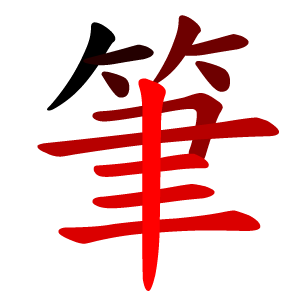
 Stroke order is the order in which the strokes of a
Stroke order is the order in which the strokes of a
File:門-order.gif, Traditional , traditional stroke order.
File:門-aorder.gif, Traditional , PRC stroke order.
File:门-jorder.gif, Simplified , traditional stroke order, comes from Cursive script.
File:门-order.gif, Simplified , PRC stroke order.
 As a general rule, strokes are written from top to bottom and left to right. For example, among the first characters usually learned is the number one, which is written with a single horizontal line: . This character has one stroke which is written from left to right.
The character for "two" has two strokes: . In this case, both are written from left to right, but the top stroke is written first. The character for "three" has three strokes: . Each stroke is written from left to right, starting with the uppermost stroke.
As a general rule, strokes are written from top to bottom and left to right. For example, among the first characters usually learned is the number one, which is written with a single horizontal line: . This character has one stroke which is written from left to right.
The character for "two" has two strokes: . In this case, both are written from left to right, but the top stroke is written first. The character for "three" has three strokes: . Each stroke is written from left to right, starting with the uppermost stroke.
 This rule also applies to the order of components. For example, can be divided into two. The entire left side () is written before the right side (). There are some exceptions to this rule, mainly occurring when the right side of a character has a lower enclosure (see below).
When there are upper and lower components, the upper components are written first, then the lower components, as in and .
2. Horizontal before vertical
This rule also applies to the order of components. For example, can be divided into two. The entire left side () is written before the right side (). There are some exceptions to this rule, mainly occurring when the right side of a character has a lower enclosure (see below).
When there are upper and lower components, the upper components are written first, then the lower components, as in and .
2. Horizontal before vertical 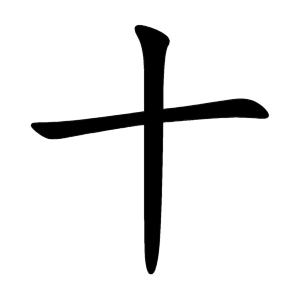 When horizontal and vertical strokes cross, horizontal strokes are usually written before vertical strokes: the character for "ten", , has two strokes. The horizontal stroke, , is written first, followed by the vertical stroke, to obtain .
In the Japanese standard, a vertical stroke may precede many intersecting horizontal strokes if the vertical stroke does not pass through the lowest horizontal stroke.
3. Character-spanning strokes last
When horizontal and vertical strokes cross, horizontal strokes are usually written before vertical strokes: the character for "ten", , has two strokes. The horizontal stroke, , is written first, followed by the vertical stroke, to obtain .
In the Japanese standard, a vertical stroke may precede many intersecting horizontal strokes if the vertical stroke does not pass through the lowest horizontal stroke.
3. Character-spanning strokes last 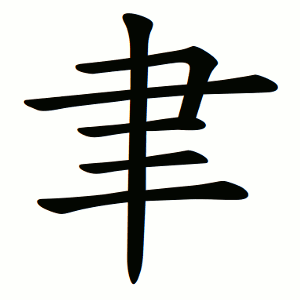 Vertical strokes that pass through many other strokes are written after the strokes through which they pass, as in and .
Horizontal strokes that pass through many other strokes are written last, as in and .
4. Diagonals right-to-left before diagonals left-to-right
Vertical strokes that pass through many other strokes are written after the strokes through which they pass, as in and .
Horizontal strokes that pass through many other strokes are written last, as in and .
4. Diagonals right-to-left before diagonals left-to-right 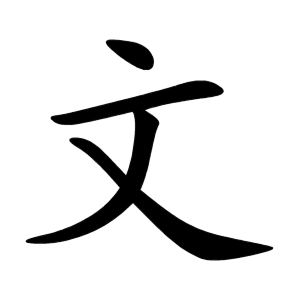 Right-to-left diagonals () are written before left-to-right diagonals (), as in .
Note that this is for symmetric diagonals; for asymmetric diagonals, as in , the left-to-right may precede the right-to-left, based on other rules.
5. Center before outside in vertically symmetrical characters
Right-to-left diagonals () are written before left-to-right diagonals (), as in .
Note that this is for symmetric diagonals; for asymmetric diagonals, as in , the left-to-right may precede the right-to-left, based on other rules.
5. Center before outside in vertically symmetrical characters  In vertically symmetrical characters, the center components are written before components on the left or right. Components on the left are written before components on the right, as in and .
6. Enclosures before contents
In vertically symmetrical characters, the center components are written before components on the left or right. Components on the left are written before components on the right, as in and .
6. Enclosures before contents 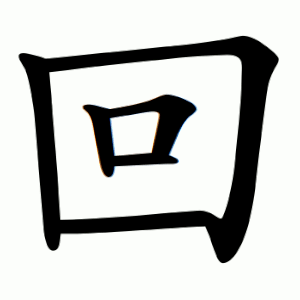
 Outside enclosing components are written before inside components; bottom strokes in the enclosure are written last if present, as in and . (A common mnemonic is "Put people inside first, then close the door.") Enclosures may also have no bottom stroke, as in and .
7. Left vertical before enclosing
Outside enclosing components are written before inside components; bottom strokes in the enclosure are written last if present, as in and . (A common mnemonic is "Put people inside first, then close the door.") Enclosures may also have no bottom stroke, as in and .
7. Left vertical before enclosing  Left vertical strokes are written before enclosing strokes. In the following two examples, the leftmost vertical stroke (, ) is written first, followed by the uppermost and rightmost lines (┐) (which are written as one stroke): and .
8. Bottom enclosures last
Left vertical strokes are written before enclosing strokes. In the following two examples, the leftmost vertical stroke (, ) is written first, followed by the uppermost and rightmost lines (┐) (which are written as one stroke): and .
8. Bottom enclosures last  Bottom enclosing components are usually written last: , , .
9. Dots and minor strokes last
Bottom enclosing components are usually written last: , , .
9. Dots and minor strokes last  Minor strokes are usually written last, as the small "dot" in the following: , , .
Minor strokes are usually written last, as the small "dot" in the following: , , .
Animated stroke order
from the California State University, Long Beach
Web resources, instructions and animations for Chinese character stroke order
Animated stroke order for Chinese characters
Stroke Order tool with option to see many characters' stroke order at once. ;ROC
Learning Program for Stroke Order of Frequently Used Chinese Characters (常用國字標準字體筆順學習網)
with animated stroke order, by the Ministry of Education, R.O.C. (Taiwan). ;Hong Kong
中英對照香港學校中文學習基礎字詞
- Lexical Items with English Explanations for Fundamental Chinese Learning in Hong Kong Schools, by the Hong Kong Education Bureau
香港標準字形及筆順
- stroke orders following the Hong Kong Education Bureau's List of Commonly Used Characters ;Japanese
from the Engineering Department of New Mexico Tech, Socorro.
Kanji alive
a free web application for learning Japanese
SODER Project
1,513 Japanese
Kakijun
Kanji stroke order animations.
Kanji stroke order font
Japanese
한자사전(漢字辭典) with stroke order diagrams
{{DEFAULTSORT:Stroke Order Chinese characters East Asian calligraphy Japanese writing system Korean writing system Ordering Orthography

 Stroke order is the order in which the strokes of a
Stroke order is the order in which the strokes of a Chinese character
Chinese characters () are logograms developed for the writing of Chinese. In addition, they have been adapted to write other East Asian languages, and remain a key component of the Japanese writing system where they are known as ''kanji' ...
(or Chinese derivative character) are written. A stroke is a movement of a writing instrument on a writing surface. Chinese characters are used in various forms in Chinese, Japanese, and Korean. They are known as '' Hanzi'' in ( Mandarin) Chinese (Traditional form: ; Simplified form: ), ''kanji
are the logographic Chinese characters taken from the Chinese script and used in the writing of Japanese. They were made a major part of the Japanese writing system during the time of Old Japanese and are still used, along with the subsequ ...
'' in Japanese (), and ''Hanja
Hanja (Hangul: ; Hanja: , ), alternatively known as Hancha, are Chinese characters () used in the writing of Korean. Hanja was used as early as the Gojoseon period, the first ever Korean kingdom.
(, ) refers to Sino-Korean vocabulary, ...
'' in Korean ().
Basic principles
Chinese character
Chinese characters () are logograms developed for the writing of Chinese. In addition, they have been adapted to write other East Asian languages, and remain a key component of the Japanese writing system where they are known as ''kanji' ...
s are basically logogram
In a written language, a logogram, logograph, or lexigraph is a written character that represents a word or morpheme. Chinese characters (pronounced '' hanzi'' in Mandarin, ''kanji'' in Japanese, ''hanja'' in Korean) are generally logograms, ...
s constructed with strokes. Over the millennia a set of generally agreed rules have been developed by custom. Minor variations exist between countries, but the basic principles remain the same, namely that writing characters should be economical, with the fewest hand movements to write the most strokes possible. This promotes writing speed, accuracy, and readability. This idea is particularly important since as learners progress, characters often get more complex. Since stroke order also aids learning and memorization, students are often taught about it from a very early age in schools and encouraged to follow them.
The Eight Principles of Yong ( Pinyin
Hanyu Pinyin (), often shortened to just pinyin, is the official romanization system for Standard Mandarin Chinese in China, and to some extent, in Singapore and Malaysia. It is often used to teach Mandarin, normally written in Chinese fo ...
: ''yǒngzì bā fǎ''; Japanese: ''eiji happō''; Korean: , ''yeongjapalbeop'', ''yŏngjap'albŏp'') uses the single character , meaning "eternity", to teach eight of the most basic strokes in Regular Script
Regular script (; Hepburn: ''kaisho''), also called (), (''zhēnshū''), (''kǎitǐ'') and (''zhèngshū''), is the newest of the Chinese script styles (popularized from the Cao Wei dynasty c. 200 AD and maturing stylistically around th ...
.
Stroke order per style
Ancient China
In ancient China, the Jiǎgǔwén characters carved on oxscapula
The scapula (plural scapulae or scapulas), also known as the shoulder blade, is the bone that connects the humerus (upper arm bone) with the clavicle (collar bone). Like their connected bones, the scapulae are paired, with each scapula on eith ...
and tortoise plastrons showed no indication of stroke order. The characters show huge variations from piece to piece, sometimes even within one piece. During the divination ceremony, after the cracks were made, the characters were written with a brush on the shell or bone (to be carved in a workshop later). Although the brush-written stroke order is not discernible after carving, there exists some evidence that it was not entirely idiosyncratic: a few of the characters, often marginal administrative notations recording the provenance of the shells or bones, were not later recarved, and the stroke order of these characters tends to resemble traditional and modern stroke order. For those characters (the vast majority) which were later engraved into the hard surface using a knife, perhaps by a separate individual, there is evidence (from incompletely engraved pieces) that in at least some cases all the strokes running one way were carved, then the piece was turned, and strokes running another way were then carved.
Imperial China
In early Imperial China, the common script was the Xiaozhuan style. About 220 BC, the emperorQin Shi Huang
Qin Shi Huang (, ; 259–210 BC) was the founder of the Qin dynasty and the first emperor of a unified China. Rather than maintain the title of " king" ( ''wáng'') borne by the previous Shang and Zhou rulers, he ruled as the First Empero ...
, the first to conquer all of China, imposed Li Si's character uniformisation, a set of 3300 standardized ''Xiǎozhuàn'' characters. Its graphs on old steles—some dating from 200 BC—reveal indications of the stroke order of the time. However, stroke order could still not yet be ascertained from the steles, and no paper from that time is extant.
The true starting point of stroke order is the Lìshū style (clerical script) which is more regularized, and in some ways similar to modern text. In theory, by looking at the Lìshū style steles' graphs and the placement of each stroke, one can see hierarchical priority between the strokes, which indicates the stroke order used by the calligrapher or stele sculptors.
Kǎishū style (regular script)—still in use today—is more regularized, allowing one to more easily guess the stroke order used to write on the steles. The stroke order 1000 years ago was similar to that toward the end of Imperial China. For example, the stroke order of is clear in the Kangxi dictionary
The ''Kangxi Dictionary'' ( (Compendium of standard characters from the Kangxi period), published in 1716, was the most authoritative dictionary of Chinese characters from the 18th century through the early 20th. The Kangxi Emperor of the Qing ...
of 1716; but in a modern book, the official stroke order (the same) will not appear clearly. The Kangxi and current shapes have tiny differences, while current stroke order is still the same, according to the old style. However, the stroke orders implied by the Kangxi dictionary are not necessarily similar to nowadays' norm.
Cursive styles and hand-written styles
Cursive styles such as '' Xíngshū'' (semi-cursive or running script) and '' Cǎoshū'' (cursive or grass script) show stroke order more clearly than Regular Script, as each move made by the writing tool is visible.Stroke order per polity
The modern governments of mainland China, Hong Kong, Taiwan, and Japan have standardized official stroke orders to be taught in schools. These stroke order standards are prescribed in conjunction to each government's standard character sets. The various official stroke orders agree on the vast majority of characters, but each has its differences. No governmental standard matches traditional stroke orders completely. The differences between the governmental standards and traditional stroke orders arise from accommodation for schoolchildren who may be overwhelmed if the rules about stroke orders are too detailed, or if there are too many exceptions. The differences listed below are not exhaustive. * Traditional stroke order: Widely used in Imperial China, currently used in theChinese cultural sphere
The East Asian cultural sphere, also known as the Sinosphere, the Sinic world, the Sinitic world, the Chinese cultural sphere, the Chinese character sphere encompasses multiple countries in East Asia and Southeast Asia that were historically ...
secondary to each region's governmental standards. Practiced mainly by informed scholars of calligraphy. Also called "calligraphic" stroke order. These stroke orders are established by study of handwritten documents from pre-Republic China, especially those of notable calligraphers. These stroke orders are most conservative regarding etymology, character construction, character evolution, and tradition. Many characters have more than one stroke correct form
Form is the shape, visual appearance, or configuration of an object. In a wider sense, the form is the way something happens.
Form also refers to:
*Form (document), a document (printed or electronic) with spaces in which to write or enter data
* ...
. Stroke orders may vary depending on the script style. Unlike the other standards, this is not a governmental standard.
* Japanese stroke order: Prescribed mostly in modern Japan
Japan ( ja, 日本, or , and formally , ''Nihonkoku'') is an island country in East Asia. It is situated in the northwest Pacific Ocean, and is bordered on the west by the Sea of Japan, while extending from the Sea of Okhotsk in the n ...
. The standard character set of the MEXT
The , also known as MEXT or Monka-shō, is one of the eleven Ministries of Japan that composes part of the executive branch of the Government of Japan. Its goal is to improve the development of Japan in relation with the international communi ...
is the Jōyō kanji, which contains many characters reformed in 1946. The MEXT lets editors freely prescribe a character's stroke order, which all should "follow commonsensical orders which are widely accepted in the society". This standard diverges from the traditional stroke order in that the two sides of the grass radical () are joined, and written with three strokes. Also, this standard is influenced by semi-cursive script
Semi-cursive script (), also known as running hand script, is a style of calligraphy which emerged in China during the Han dynasty (3rd century BC – 3rd century AD). The style is used to write Chinese characters and is abbreviated slightly ...
, leading to some vertical strokes to precede intersecting horizontal strokes if the vertical stroke does not pass through the lowest horizontal stroke, as in and . is written with the top dot first, while the traditional stroke order writes the first.
* Taiwan stroke order (): Prescribed mostly in modern Taiwan
Taiwan, officially the Republic of China (ROC), is a country in East Asia, at the junction of the East and South China Seas in the northwestern Pacific Ocean, with the People's Republic of China (PRC) to the northwest, Japan to the no ...
. The standard character set of the ROC Ministry of Education is the Standard Form of National Characters. This standard diverges from the traditional stroke order in that the upper-right dot of the component is written second to last. The vertical stroke in is written second. starts with the horizontal. Also, the component, as seen in and , is written with the horizontal stroke first in all instances, while the traditional stroke order differentiates the stroke order of according to etymology and character structure.
* Mainland China stroke order: Prescribed mostly in modern Mainland China
"Mainland China" is a geopolitical term defined as the territory governed by the China, People's Republic of China (including islands like Hainan or Chongming Island, Chongming), excluding dependent territories of the PRC, and other territorie ...
. In 1956, the government of the PRC introduced many newly created characters and substitutions, called Simplified Chinese character
Simplified Chinese characters are standardized Chinese characters used in mainland China, Malaysia and Singapore, as prescribed by the ''Table of General Standard Chinese Characters''. Along with traditional Chinese characters, they are one o ...
s, which form part of the PRC Ministry of Education's standard character set, the Xiàndài Hànyǔ Chángyòng Zìbiǎo. This in turn reformed the stroke order of many characters. Besides these characters, this standard diverges from the traditional stroke order in characters with the radical, merging both sides like the Japanese standard. Also, the horizontal stroke of the component is written first in all instances. ends with . starts with the horizontal. In 1997, the PRC Ministry of Education published the official stroke order standard for commonly used characters.
* Hong Kong stroke order: Prescribed mostly in modern Hong Kong
Hong Kong ( (US) or (UK); , ), officially the Hong Kong Special Administrative Region of the People's Republic of China (abbr. Hong Kong SAR or HKSAR), is a List of cities in China, city and Special administrative regions of China, special ...
. The standard character set of the Hong Kong Education Bureau is the List of Forms of Frequently Used Characters. In this standard, is written vertical–horizontal–vertical–horizontal, instead of the traditional vertical–horizontal–horizontal–vertical. starts with the horizontal.
Alternative stroke orders
Besides general errors and regional differences in stroke order, it is common in the PRC to apply alternative stroke orders which resemble PRC stroke orders to Traditional Chinese characters, although the PRC generally uses Simplified characters. In the below example, the traditional character (simplified: ) is shown with both the traditional stroke order (left, starting with the left vertical stroke), as in imperial China, Taiwan, Japan, and Hong Kong, and with the Simplified stroke order (right, with the left vertical stroke fourth).General guidelines
''Note: There are exceptions within and among different standards. The following are only guidelines.'' 1. Write from top to bottom, and left to right. As a general rule, strokes are written from top to bottom and left to right. For example, among the first characters usually learned is the number one, which is written with a single horizontal line: . This character has one stroke which is written from left to right.
The character for "two" has two strokes: . In this case, both are written from left to right, but the top stroke is written first. The character for "three" has three strokes: . Each stroke is written from left to right, starting with the uppermost stroke.
As a general rule, strokes are written from top to bottom and left to right. For example, among the first characters usually learned is the number one, which is written with a single horizontal line: . This character has one stroke which is written from left to right.
The character for "two" has two strokes: . In this case, both are written from left to right, but the top stroke is written first. The character for "three" has three strokes: . Each stroke is written from left to right, starting with the uppermost stroke.
 This rule also applies to the order of components. For example, can be divided into two. The entire left side () is written before the right side (). There are some exceptions to this rule, mainly occurring when the right side of a character has a lower enclosure (see below).
When there are upper and lower components, the upper components are written first, then the lower components, as in and .
2. Horizontal before vertical
This rule also applies to the order of components. For example, can be divided into two. The entire left side () is written before the right side (). There are some exceptions to this rule, mainly occurring when the right side of a character has a lower enclosure (see below).
When there are upper and lower components, the upper components are written first, then the lower components, as in and .
2. Horizontal before vertical  When horizontal and vertical strokes cross, horizontal strokes are usually written before vertical strokes: the character for "ten", , has two strokes. The horizontal stroke, , is written first, followed by the vertical stroke, to obtain .
In the Japanese standard, a vertical stroke may precede many intersecting horizontal strokes if the vertical stroke does not pass through the lowest horizontal stroke.
3. Character-spanning strokes last
When horizontal and vertical strokes cross, horizontal strokes are usually written before vertical strokes: the character for "ten", , has two strokes. The horizontal stroke, , is written first, followed by the vertical stroke, to obtain .
In the Japanese standard, a vertical stroke may precede many intersecting horizontal strokes if the vertical stroke does not pass through the lowest horizontal stroke.
3. Character-spanning strokes last  Vertical strokes that pass through many other strokes are written after the strokes through which they pass, as in and .
Horizontal strokes that pass through many other strokes are written last, as in and .
4. Diagonals right-to-left before diagonals left-to-right
Vertical strokes that pass through many other strokes are written after the strokes through which they pass, as in and .
Horizontal strokes that pass through many other strokes are written last, as in and .
4. Diagonals right-to-left before diagonals left-to-right  Right-to-left diagonals () are written before left-to-right diagonals (), as in .
Note that this is for symmetric diagonals; for asymmetric diagonals, as in , the left-to-right may precede the right-to-left, based on other rules.
5. Center before outside in vertically symmetrical characters
Right-to-left diagonals () are written before left-to-right diagonals (), as in .
Note that this is for symmetric diagonals; for asymmetric diagonals, as in , the left-to-right may precede the right-to-left, based on other rules.
5. Center before outside in vertically symmetrical characters  In vertically symmetrical characters, the center components are written before components on the left or right. Components on the left are written before components on the right, as in and .
6. Enclosures before contents
In vertically symmetrical characters, the center components are written before components on the left or right. Components on the left are written before components on the right, as in and .
6. Enclosures before contents 
 Outside enclosing components are written before inside components; bottom strokes in the enclosure are written last if present, as in and . (A common mnemonic is "Put people inside first, then close the door.") Enclosures may also have no bottom stroke, as in and .
7. Left vertical before enclosing
Outside enclosing components are written before inside components; bottom strokes in the enclosure are written last if present, as in and . (A common mnemonic is "Put people inside first, then close the door.") Enclosures may also have no bottom stroke, as in and .
7. Left vertical before enclosing  Left vertical strokes are written before enclosing strokes. In the following two examples, the leftmost vertical stroke (, ) is written first, followed by the uppermost and rightmost lines (┐) (which are written as one stroke): and .
8. Bottom enclosures last
Left vertical strokes are written before enclosing strokes. In the following two examples, the leftmost vertical stroke (, ) is written first, followed by the uppermost and rightmost lines (┐) (which are written as one stroke): and .
8. Bottom enclosures last  Bottom enclosing components are usually written last: , , .
9. Dots and minor strokes last
Bottom enclosing components are usually written last: , , .
9. Dots and minor strokes last  Minor strokes are usually written last, as the small "dot" in the following: , , .
Minor strokes are usually written last, as the small "dot" in the following: , , .
Representations
There are various ways to describe the stroke order of a character. Children learn the stroke order in courses, as part of writing learning. Various graphical representations are possible, most notably successive images of the character with one more stroke added (or changing color) each time, numbering strokes, color-coding, fanning, and more recently animations. Stroke order is often described in person by writing characters on paper or in the air.See also
*Chinese character
Chinese characters () are logograms developed for the writing of Chinese. In addition, they have been adapted to write other East Asian languages, and remain a key component of the Japanese writing system where they are known as ''kanji' ...
* Chinese characters description languages
* CJK strokes
* Horizontal and vertical writing in East Asian scripts
Many East Asian scripts can be written horizontally or vertically. Chinese, Japanese, Vietnamese Hán- Nôm and Korean scripts can be oriented along either axis, as they consist mainly of disconnected logographic or syllabic units, each occ ...
* Radical (Chinese character)
Notes
References
;Traditional stroke order * * ;ROC stroke order * (Authoritative) ;PRC stroke order * (Authoritative) ;Japanese * (Authoritative from 1958 to 1977). * Hadamitzky, Wolfgang & Mark Spahn. ''A Handbook of the Japanese Writing System''. Charles E. Tuttle Co. . * Henshall, Kenneth G. ''A Guide to Remembering Japanese Characters''. Charles E. Tuttle Co. . * O'Neill, P.G. ''Essential Kanji: 2,000 Basic Japanese Characters Systematically Arranged for Learning and Reference''. Weatherhill. . * ** Includes a translation of the Japanese Ministry of Education rules on Kanji stroke order. ;Hong Kong * . Online version available at http://www.edbchinese.hk/lexlist_ch/. (Print version is official curriculum supporting material.) ;Archaic characters * ;Other issues * *External links
;PRCAnimated stroke order
from the California State University, Long Beach
Web resources, instructions and animations for Chinese character stroke order
Animated stroke order for Chinese characters
Stroke Order tool with option to see many characters' stroke order at once. ;ROC
Learning Program for Stroke Order of Frequently Used Chinese Characters (常用國字標準字體筆順學習網)
with animated stroke order, by the Ministry of Education, R.O.C. (Taiwan). ;Hong Kong
中英對照香港學校中文學習基礎字詞
- Lexical Items with English Explanations for Fundamental Chinese Learning in Hong Kong Schools, by the Hong Kong Education Bureau
香港標準字形及筆順
- stroke orders following the Hong Kong Education Bureau's List of Commonly Used Characters ;Japanese
from the Engineering Department of New Mexico Tech, Socorro.
Kanji alive
a free web application for learning Japanese
kanji
are the logographic Chinese characters taken from the Chinese script and used in the writing of Japanese. They were made a major part of the Japanese writing system during the time of Old Japanese and are still used, along with the subsequ ...
with stroke order animations.SODER Project
1,513 Japanese
kanji
are the logographic Chinese characters taken from the Chinese script and used in the writing of Japanese. They were made a major part of the Japanese writing system during the time of Old Japanese and are still used, along with the subsequ ...
stroke order diagrams and animations, freely downloadable under license.Kakijun
Kanji stroke order animations.
Kanji stroke order font
Japanese
kanji
are the logographic Chinese characters taken from the Chinese script and used in the writing of Japanese. They were made a major part of the Japanese writing system during the time of Old Japanese and are still used, along with the subsequ ...
stroke order diagrams presented as a TrueType font.
;Korean한자사전(漢字辭典) with stroke order diagrams
{{DEFAULTSORT:Stroke Order Chinese characters East Asian calligraphy Japanese writing system Korean writing system Ordering Orthography